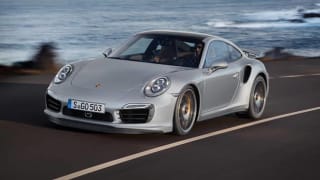
Porsche 911 Turbo and Turbo S 2014 review
It makes us look good - but so it should, at $359,800.
Browse over 9,000 car reviews
Two decades ago Jim Richards and Mark Skaife famously thumbed their noses at Aussie fans’ jibes after winning their second and final outright victory in the Bathurst 1000 in a Nissan GT-R Skyline.
Since then the GT-R, which Nissan claims is the world’s most affordable supercar, has continued to take it up to the sportscar elites costing an arm, and often a leg as well, more.
Now the Japanese auto maker has dropped off its latest GT-R in Australia with a bargain-basement price of $170,800. Just what does the buyer get for his or her buck?

Well, there’s the powertrain for a start. The engine pumps out more power than its predecessor, while at the same time using less fuel and producing fewer emissions; transmission shift feel has been improved and specially prepared race tuned oils are used in the differential. Equipment levels have been increased and there’s a fascinating new suspension setup.
The heart (and soul) of the new GT-R is, of course, the engine, which now puts out 404 kW (540 horsepower) at 6400 rpm, as opposed to 390 kW previously, while maximum torque has gone up from 612 Nm to 628 Nm between 3200 and 5800 revs. Fuel use is cut from 12.0 to 11.7 litres per kilometre, says Nissan.
Each 3.8-litre twin-turbo V6 motor is put together by hand by one of a team of eight builders – each team knocking out two units a day. For example, craftsmen precisely match the ports of the intake manifold and cylinder head. So there is minimum disturbance to the airflow, thus increasing performance.
Sodium filled valves mean better cooling, while the catalytic converter has been cut by half thanks to a more efficient catalyst. Engine efficiency has been further extended by using a leaner air/fuel mix and optimising valve and ignition timing.
Power is put to ground via a six-speed double-clutch transmission and independent transaxle all-wheel drive system. Shift feel and quietness have been refined.
An asymmetric suspension has been designed to give bias to the right-hand drive vehicle. It takes into account the weight of the driver – other occupants are ignored, balance being considered only when it really matters, at race track speeds. Also, the prop shaft driving the front wheels in the AWD system is on the right side of the car, again adding right-hand weight bias.
Up front are harder spring rates on the left, while out back the rear suspension arm has been fitted upwards on the left and downwards on the right. The result is, with extensive fine tuning on the Nurburgring north circuit (where else?) vertical load on all four tyres has been equalised.
Thus, steering response is improved, as is cornering and ride comfort, the last bettered even more by suspension settings switchable between ‘comfort’, ‘normal’ and ‘race track’ by the driver.
The latest Nissan GT-R has a stronger body structure to take power and torque increases and improve handling. In conjunction with new Dunlop SP Sport Maxx tyres, developed especially for the GT-R, the driver gets a better feel of road grip transmitted through the steering wheel.
A standard 2+2 coupe, there is little leg room in the rear but a 315 litre boot does not skimp for space. Improvements to the cabin include better looking instruments with blue lighting inside the tachometer matching the shift indicator, while a rear-view camera eases limited vision when reversing.
The Bose sound system has been given a boost with woofers that were previously only available with the Egoist spec GT-R. Door speakers and woofer in the rear are now mounted on a solid aluminium panel to reduce vibration and improve sound quality.
A 300 km-plus drive in Tasmania on roads including several Targa sections produced miles of smiles as the GT-R showed off its wares. We particularly liked the action of the fixed position steering wheel-mounted shift paddles.
The sound coming from the dual twin exhausts perfectly matched the way the car was performing and road grip was such that there was a distinct lack of tyre distress on tight bends.
All in all, the quality of the experience well matched that enjoyed in sports cars costing a great deal more, a fact backed by the claim that Nissan has found the likes of Aston Martin and Porsche 911 owners also enjoying ownership of GT-Rs. It’s that kind of car.
The ‘most affordable supercar’ has a recommended retail of just $170,800, plus on-road costs and will surely add to Nissan’s previous GT-R successes of sales to 420 Australians and 20,000 buyers worldwide.
| Vehicle | Specs | Price* | |
|---|---|---|---|
| (base) | 3.8L, PULP, 6 SP DUAL-CLUTCH AUTO | $82,060 – 94,380 | 2012 Nissan GT-R 2012 (base) Pricing and Specs |
$81,510
Lowest price, based on third party pricing data